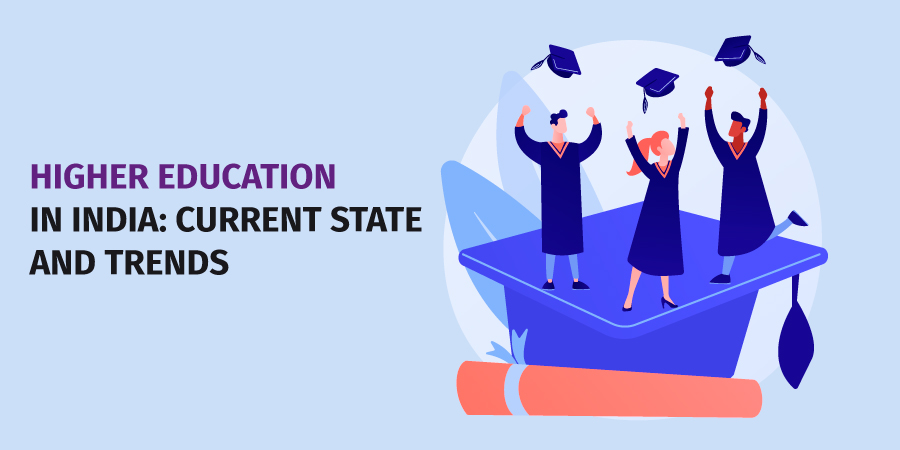Higher Education in India: Current State and Trends

Since the onset of the COVID-19 pandemic, the Higher Educational Institutes (HEIs) of India have been forced to shut down and give focus on a lot of online teaching and virtual classrooms. On the surface, according to the 2021 Changing Landscape of Online Education (CHLOE) report, this resulting pivot to online learning has increased the adoption of many educational tools in the higher education system.
Educational Technology or EdTech is playing a vital role in the Indian education system and would grow at a Compounded Annual Growth Rate (CAGR) of approximately 30% to reach the market size of USD 10.4 billion by 2025. From academic curriculum to admission management and assessments for the students, EdTech has seen massive growth in various institutes. Numerous things have changed in the educational ecosystem and will undergo more in the next 5 to 10 years.
Higher Education Ecosystem in India
Undeniably, Student Life Cycle Management (SLCM) is one of the most important goals for any college or university. It is a data-driven approach that helps to manage the entire journey from student admission to alumni. However, institutes face the challenges to maintain the quality of education and facilitating the environment to prolong the student & faculty relationships in such tough times of college & university closures. Hence, there is a clear need of encouraging an all-in-one SAAS (Software as a Service) EdTech platform to help the institutions with an aim to automate their operational processes, provide end-to-end unified solutions and simplify their tasks by eventually, improving the overall experience. This has in turn enabled high Return On Investment (ROI) for various EdTech players and institutes. Camu Digital Campus is the global EdTech cloud solution that empowers educational institutions to meet their academic goals seamlessly.
The New Era of Higher Educational System
The power of EdTech has already experienced rapid growth and adoption in various educational institutions. These campus management solutions for higher education have enabled the faculties to use a multi-model approach to learning, which includes mixed-media content, graphics, experimental kits and much more. This enables the professors to provide unique methodologies of teaching that meet the global standards. Furthermore, the online attendance of students with the real-time teaching, scheduling of online assessments or exams, easy generating the online reports of students and collection of fee payments online ease the scholastic and administrative processes of institutes.
NEP 2020 Reinforces the Importance of Technology
The National Education Policy (NEP) 2020 attempts to build a holistic and multidisciplinary educational system in the country. When it is implemented well, the outcome would be the development of a knowledgeable and skilled nation that can solve its issues on its own, connecting in a big way to the AtmaNirbhar Bharat Vision. NEP 2020 has also put a special emphasis on online and digital education. This will set the way for EdTech to be increasingly integrated into the higher education system of India and enable more cost-efficient methods.
Higher Education Trends
Below are the top 4 higher education trends that are likely to take shape in 2022.
- Adoption of Hybrid Learning
Hybrid learning doesn’t mean the combination of a virtual and physical classroom. But, allowing for immersive and experimental learning that means it enables the students to apply concepts learned in the classroom out in the real world. So, rather than shifting from the “learn from anywhere” approach, higher educational institutions should move to the “learn from everywhere” approach.
- Continue to Focus on Teaching Skills
Universities focusing on teaching specific skills remain relevant involving the latest technologies, even though the technologies that support them have become outdated. As a result, the universities are forever well-versed with the latest skills needed in the future workspace. Thus, they can teach the skills that remain applicable to the new, changing and unknown contexts.
- Formative Assessment on Boom instead of high-stake exams
Many people gain higher education based on standardized tests that don’t measure any competency level. However, nowadays, many universities are attempting to replace these high-stake standardized exams with other assessment measures that not only examine the learning outcomes but also will focus on improving them. These formal and informal evaluations through the student learning journey are known as formative assessments and are going to rage in the year 2022 and after the next 5 years.
- Replacing Lectures with Active Learning
Although lectures are an efficient way of teaching but an ineffective way of learning. For centuries, it has been used in universities and colleges as a cost-effective method for faculties to impart knowledge to students. However, with the effect of digital and online education, the college closures have shed the light on Outcome Based Education(OBE), which engrossed both skills and knowledge of students.
Challenges, Prospects and Possibilities
The challenges of online or digital education can be the lack of technical knowledge in the faculties or the internet availability. But, it is highly unlikely that digital education will replace the traditional one in higher education institutes. Blended learning would be the future outlook in the Indian educational system, whose aim is to provide a balance between physical and online learning.
The adoption of blended learning with the use of advanced technology creates endless possibilities and is a key enabler for enhancing the quality of education and overall efficiency in the higher education ecosystem of India.











